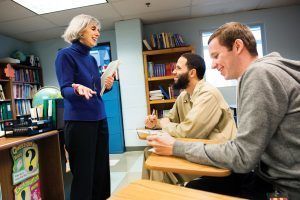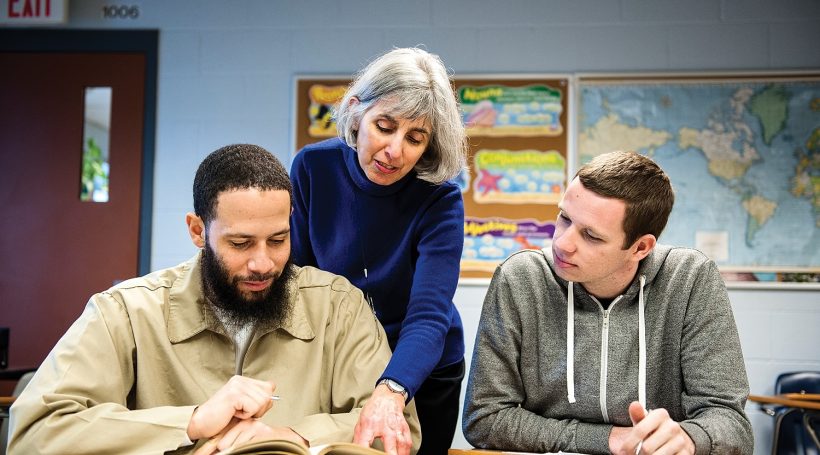To get to class last semester, Brian Gregg had to go through rigorous security checks, metal detectors and locked doors.
Gregg, 21, and eight other Rutgers University students were part of a course on the corrections system held at South Woods State Prison in Bridgeton. The other 11 members of the class were inmates enrolled in the New Jersey Scholarship and Transformative Education in Prisons Consortium (NJ-STEP). The course was the first of its kind in South Jersey, spearheaded by Professor Jane Siegel, chair of the Sociology, Anthropology and Criminal Justice departments at Rutgers-Camden.
“The idea came from a program that originated at Temple University,” Siegel says. “There’s a professor there who took her students to jails in Philadelphia to show them what it was really like. I loved this idea of learning together and breaking down those walls.”
Siegel worked for over a year to lay the groundwork for the program, getting approvals from prison officials and training from Temple University’s Inside-Out Prison Exchange Program. Once the class was opened for enrollment, Siegel handpicked the Rutgers students, including Gregg, whom she felt would most appreciate the unique course offering. She met with each of them in advance to explain what the course would entail, but she couldn’t quite prepare them for the experience ahead.
“Our first orientation in the prison was really dramatic,” Gregg says. “We were told, ‘These are bad people who’ve done bad things. You can’t trust them.’ I didn’t know what to expect, but I had worked in Camden in a community with a large population of people who have family members in jail. I think I had an understanding that made me more open.”
Siegel planned a series of icebreakers for the class’ first meeting. Both the “inside students” and the “outside students” were uncomfortable at first, but she says the tension dissipated quickly once they started talking.

Professor Jane Siegel meets with inmate Chris Charriez and Rutgers student Brian Gregg in a classroom at South Woods State Prison in Bridgeton
“They were all definitely apprehensive,” she says. “So I moved the desks into two circles, one around the other, and had them sit facing each other. I gave them sentence completions like, ‘My favorite TV show growing up was…’ And then the students in the inner circle would move one seat over for the next question. This way each inside student got to talk to each outside student, and vice versa. The outside students had been told not to look the inside students in the eye, which was difficult because they were sitting face-to-face. So immediately, they couldn’t do that.”
Gregg says he very quickly began to see the inmates not as criminals, but simply as fellow students.
“It was clear from the beginning that parts of the corrections system are designed to take the humanity out of people,” Gregg says. “‘Don’t look them in the eye’ is something you say about a vicious animal. But sharing something as simple as eye contact went a long way toward making us all feel like we could set aside those differences and just learn.”
After that initial meeting with all the students, Siegel met separately with the two groups. She wasn’t expecting the reactions they had to the first class.
“One of the outside students said when she got in her car to go home, she turned off her radio and drove home in silence, thinking about what she’d experienced,” Siegel says. “Then another said, ‘I did the same thing,’ and another said, ‘Me too,’ and I thought, ‘Wow, this is really something.’”
“The next night with the inside students, one said he hadn’t been able to sleep all night after the class,” Siegel continues. “And another said, ‘Yeah, me too.’ I thought, ‘This is the same as turning off the radio.’ It amazed me that it had such a profound impact on them right off the bat.”
The class met about a dozen times over the course of the semester, covering a curriculum that centered on the strengths and failings of the correctional system. Christopher Charriez, one of the inmates in the class, says the subject matter placed the inside students under a certain amount of pressure.
“It creates a strange dynamic, being in the presence of free-living people,” Charriez, 36, says. “All the while I think we were cognizant of the responsibility to bridge the gap with people on the outside as to what affects us and what ultimately may lead to affecting the community.”
Gregg considers the course one of the best he’s taken in his entire collegiate career and largely attributes that to the attitude the incarcerated students brought to class.
“I miss going there,” he says, “because it was the best class of people I’ve been a part of since being in college. They respected you and your opinions, and you don’t always gets that in a classroom.”
Charriez, who’s been in the corrections system since the age of 15, says the connections the students made with one another were built on that foundation of respect and aided along by the fact that the classmates tended to agree on the concepts discussed in the course.
“I had a great respect for them, because they chose a route in life that at that age I did not choose,” Charriez says. “I’d chosen a different path, obviously. It was the concepts that brought us together. When we got into the dynamics of how we would punish people if we were on a panel that metes out punishments, we found a majority of us held a level of compassion for the criminal in some instances.”
Despite the openness she fostered in the classroom, Siegel also maintained a few ground rules, designed to protect the safety and privacy of both groups. They used first names only, and there was a strict no-asking rule when it came to the crimes the inside students had been convicted of.
“Our professor never, at any point, told us what they’d done to get to prison,” Gregg says. “Later, some of us went online of course and were like, ‘Oh, let me see if I can find out,’ but I think it was good to meet them as people before knowing. Before we went there, Professor Siegel asked us to think about the worst thing we’d ever done. She asked us, ‘How would you feel if that’s all you were for the rest of your life?’”
Siegel feels her students left the class with a new appreciation for the necessity of programs like NJ-STEP, which she says benefit not just the prisoners themselves, but society at large.
“The hope is when they get out of prison, they won’t go back,” Siegel says.
Charriez has about five years remaining on his 25-year prison sentence. He is pursuing an associate’s degree in liberal arts, and when he is released he hopes to obtain a bachelor’s degree. Charriez says he plans to use the education he’s received to improve the corrections system and to prevent at-risk teens from becoming a part of it.
Gregg, who aims to teach in disadvantaged school districts after graduation, says he was impressed by the inside students’ plans to help their own communities after they’re released.
“At the end we had a debrief, and we got to talk about the future,” Gregg says. “It was really awesome to hear a lot of them are interested in going back to where they came from to help children in similar situations.”
“My degree is an investment in my community,” Charriez says. “This degree is a means for me to take my unfortunate route I took in life, and use it to save someone else who’s considering that same fork in the road.”












